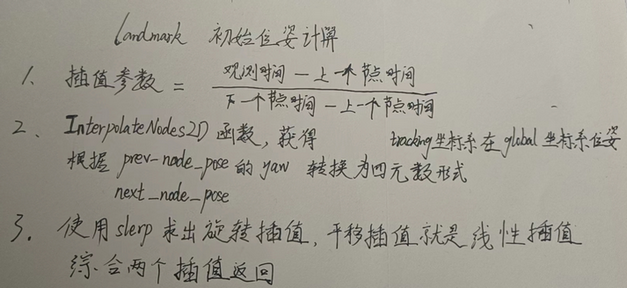

landmark的后端处理
source link: https://charon-cheung.github.io/2022/12/22/%E6%BF%80%E5%85%89SLAM/Cartographer/%E6%BA%90%E7%A0%81%E8%A7%A3%E8%AF%BB/landmark%E7%9A%84%E5%90%8E%E7%AB%AF%E5%A4%84%E7%90%86/#Solve-%E5%92%8C-RunOptimization-%E7%9A%84%E6%9C%80%E5%90%8E%E5%A4%84%E7%90%86
Go to the source link to view the article. You can view the picture content, updated content and better typesetting reading experience. If the link is broken, please click the button below to view the snapshot at that time.

landmark的后端处理 | 沉默杀手
加入landmark后,Pose Graph有了不同的node和edge,也就是landmark也作为node,landmark-pose之间的 edge是新的一种edge,即在pose对landmark的观测
struct LandmarkNode {
struct LandmarkObservation {
int trajectory_id;
common::Time time;
transform::Rigid3d landmark_to_tracking_transform;
double translation_weight;
double rotation_weight;
};
// 同一时刻,可能观测到多个landmark数据
std::vector<LandmarkObservation> landmark_observations;
absl::optional<transform::Rigid3d> global_landmark_pose;
bool frozen = false;
};
landmark是应用于后端,不是实时的,应当调大权重让carto更相信它的结果
添加数据部分
void PoseGraph2D::AddLandmarkData(int trajectory_id,
const sensor::LandmarkData& landmark_data)
{
AddWorkItem([=]() LOCKS_EXCLUDED(mutex_) {
absl::MutexLock locker(&mutex_);
if (CanAddWorkItemModifying(trajectory_id)) {
for (const auto& observation : landmark_data.landmark_observations)
{
// initial landmark_nodes
// const transform::Rigid3d global_pose =
// observation.landmark_to_map_transform;
#if 0
data_.landmark_nodes的类型是 std::map<std::string /* landmark ID */, PoseGraphInterface::LandmarkNode>
#endif
data_.landmark_nodes[observation.id].landmark_observations.emplace_back(
PoseGraphInterface::LandmarkNode::LandmarkObservation{
trajectory_id, landmark_data.time,
observation.landmark_to_tracking_transform,
observation.translation_weight, observation.rotation_weight} );
// data_.landmark_nodes[observation.id].global_landmark_pose = global_pose;
}
}
// optimization_problem_->new_landmark_add_ = true;
return WorkItem::Result::kDoNotRunOptimization;
});
}
这里就是把观测到的landmark信息都保存到data_.landmark_nodes,最后返回的标识也是不优化
后端优化的流程和其他传感器数据一样:PoseGraph2D::HandleWorkQueue —— PoseGraph2D::RunOptimization —— OptimizationProblem2D::Solve(data_.constraints, GetTrajectoryStates(), data_.landmark_nodes) —— AddLandmarkCostFunctions(landmark_nodes, node_data_, &C_nodes, &C_landmarks, &problem, options_.huber_scale() )
OptimizationProblem2D::Solve部分:
std::set<int> frozen_trajectories;
for (const auto& it : trajectories_state)
{
if (it.second == PoseGraphInterface::TrajectoryState::FROZEN)
{
frozen_trajectories.insert(it.first);
}
}
ceres::Problem::Options problem_options;
ceres::Problem problem(problem_options);
// Set the starting point. TODO(hrapp): Move ceres data into SubmapSpec.
// ceres需要的是double指针,std::array 能转成原始指针的形式
MapById<SubmapId, std::array<double, 3>> C_submaps;
MapById<NodeId, std::array<double, 3>> C_nodes;
std::map<std::string, CeresPose> C_landmarks;
bool first_submap = true;
// 将需要优化的 子图位姿 设置为优化参数
for (const auto& submap_id_data : submap_data_) {
// submap_id的轨迹是否是冻结的
const bool frozen =
frozen_trajectories.count(submap_id_data.id.trajectory_id) != 0;
// 将子图的global_pose放入 C_submaps
C_submaps.Insert(submap_id_data.id,
FromPose(submap_id_data.data.global_pose));
// c++11中,std::array::data()返回指向数组对象第一个元素的指针
problem.AddParameterBlock(C_submaps.at(submap_id_data.id).data(), 3);
// 第一个子图或冻结,不优化子图位姿。 也就是不优化初值
if (first_submap || frozen) {
first_submap = false;
// Fix the pose of the first submap or all submaps of a frozen
// trajectory.
problem.SetParameterBlockConstant(C_submaps.at(submap_id_data.id).data());
}
}
// 需要优化的 节点位姿 设置为优化参数,与上面的子图优化大致相同
for (const auto& node_id_data : node_data_)
{
const bool frozen =
frozen_trajectories.count(node_id_data.id.trajectory_id) != 0;
C_nodes.Insert(node_id_data.id, FromPose(node_id_data.data.global_pose_2d));
problem.AddParameterBlock(C_nodes.at(node_id_data.id).data(), 3);
if (frozen)
{
// 这里的第一个节点也要参与优化,跟子图的不同了
problem.SetParameterBlockConstant(C_nodes.at(node_id_data.id).data());
}
}
/* ...... */
// 第2种残差:landmark与landmark数据插值出来的节点相对位姿的差值
AddLandmarkCostFunctions(landmark_nodes, node_data_,
&C_nodes, &C_landmarks,
&problem, options_.huber_scale() );
landmark数据 与 通过2个节点位姿插值出来的相对位姿 的差值作为残差项
AddLandmarkCostFunctions
最外层两个循环是遍历landmark节点和遍历每个节点的观测,也就是说可能会同时看到多个landmark。直接看循环里面的内容
const std::string& landmark_id = landmark_node.first;
// 轨迹中第一个 node_data
const auto& begin_of_trajectory =
node_data.BeginOfTrajectory(observation.trajectory_id);
// 如果 landmark observation was made before the trajectory was created
if (observation.time < begin_of_trajectory->data.time) {
continue;
}
/* 以下语句Find the trajectory nodes before and after the landmark observation */
// 找到在landmark观测时间后的第一个节点
auto next =
node_data.lower_bound(observation.trajectory_id, observation.time);
/* The landmark observation was made, but the next trajectory node has
not been added yet. 即next已经是轨迹最后一个节点 */
if (next == node_data.EndOfTrajectory(observation.trajectory_id) ) {
continue;
}
// 如果是刚开始的node data
if (next == begin_of_trajectory) {
next = std::next(next);
}
// 这里的pre配合next是为了获取两个位置,找到landmark观测时间的前一个节点
auto prev = std::prev(next);
// 根据两个索引,获取两个节点位姿
// Add parameter blocks for the landmark ID if they were not added before
std::array<double, 3>* prev_node_pose = &C_nodes->at(prev->id);
std::array<double, 3>* next_node_pose = &C_nodes->at(next->id);
根据landmark观测的时间,找到观测前后的节点,获取位姿
// 如果landmark_id 不存在于 C_landmarks,
if (!C_landmarks->count(landmark_id)){
// landmark如果已经优化,则 global_landmark_pose 有值
// 否则根据时间插值计算一个位姿
const transform::Rigid3d starting_point =
landmark_node.second.global_landmark_pose.has_value()
? landmark_node.second.global_landmark_pose.value()
: GetInitialLandmarkPose(observation, prev->data, next->data,
*prev_node_pose, *next_node_pose);
开始C_landmarks当然为空,只有在优化完成后,这里才存在,即 RunOptimization 的最后会添加: data_.landmark_nodes[landmark.first].global_landmark_pose = landmark.second;,顺着上面的调用路线就能发现
GetInitialLandmarkPose
这里用了一堆数据类型转换,以及四元数、旋转向量、欧拉角之间的转换。还重新实现了slerp函数SlerpQuaternions,因为Eigen的slerp与Ceres的不兼容。
C_landmarks->emplace(
landmark_id,
// 四元数不支持广义加法,使用QuaternionParameterization
CeresPose(starting_point, nullptr /* translation_parametrization */,
absl::make_unique<ceres::QuaternionParameterization>(),
problem) );
// Set landmark constant if it is frozen. 不参与优化
// 这里容易记不清,frozen 定义在 struct LandmarkNode
if (landmark_node.second.frozen) {
problem->SetParameterBlockConstant(
C_landmarks->at(landmark_id).translation());
problem->SetParameterBlockConstant(
C_landmarks->at(landmark_id).rotation());
}
}
CeresPose的构造函数里就两行
problem->AddParameterBlock(data_->translation.data(), 3,
translation_parametrization.release());
problem->AddParameterBlock(data_->rotation.data(), 4,
rotation_parametrization.release());
对于平移,无需ceres::LocalParameterization
添加残差块
problem->AddResidualBlock(
LandmarkCostFunction2D::CreateAutoDiffCostFunction(
observation, prev->data, next->data),
new ceres::HuberLoss(huber_scale),
prev_node_pose->data(), next_node_pose->data(),
C_landmarks->at(landmark_id).rotation(),
C_landmarks->at(landmark_id).translation() );
if (!C_landmarks->count(landmark_id))已经结束,添加残差块。
Solve 和 RunOptimization 的最后处理
Solve的最后
for (const auto& C_landmark : C_landmarks) {
// first 是 landmark_id
landmark_data_[C_landmark.first] = C_landmark.second.ToRigid();
}
这个C_landmarks还是上面那个,ToRigid()当然是优化后的landmark全局位姿了
在RunOptimization的最后
// 遍历成员变量 landmark_data_,它在 Solve 函数的最后赋值
for (const auto& landmark : optimization_problem_->landmark_data() )
{
// first 是 landmark_id
data_.landmark_nodes[landmark.first].global_landmark_pose = landmark.second;
}
optimization_problem_->landmark_data()返回的就是上面的landmark_data_,说白了,这里就是把优化后的landmark数据从OptimizationProblem2D层传回PoseGraph2D层
Recommend
About Joyk
Aggregate valuable and interesting links.
Joyk means Joy of geeK
